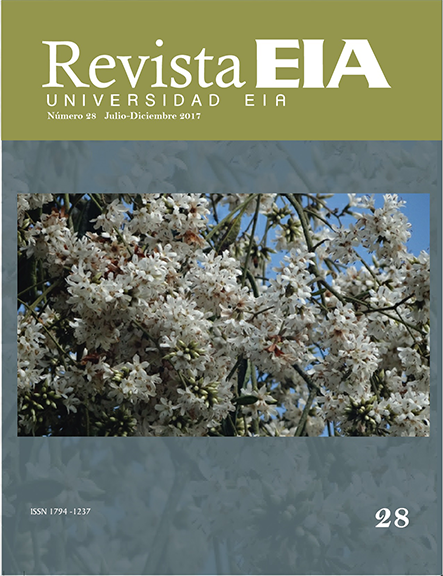Modelación de la contribución arbórea en análisis de susceptibilidad a deslizamientos superficiales
Modelación de la contribución arbórea en análisis de susceptibilidad a deslizamientos superficiales
Barra lateral del artículo
Términos de la licencia (VER)
Declaración del copyright
Los autores ceden en exclusiva a la Universidad EIA, con facultad de cesión a terceros, todos los derechos de explotación que deriven de los trabajos que sean aceptados para su publicación en la Revista EIA, así como en cualquier producto derivados de la misma y, en particular, los de reproducción, distribución, comunicación pública (incluida la puesta a disposición interactiva) y transformación (incluidas la adaptación, la modificación y, en su caso, la traducción), para todas las modalidades de explotación (a título enunciativo y no limitativo: en formato papel, electrónico, on-line, soporte informático o audiovisual, así como en cualquier otro formato, incluso con finalidad promocional o publicitaria y/o para la realización de productos derivados), para un ámbito territorial mundial y para toda la duración legal de los derechos prevista en el vigente texto difundido de la Ley de Propiedad Intelectual. Esta cesión la realizarán los autores sin derecho a ningún tipo de remuneración o indemnización.
La autorización conferida a la Revista EIA estará vigente a partir de la fecha en que se incluye en el volumen y número respectivo en el Sistema Open Journal Systems de la Revista EIA, así como en las diferentes bases e índices de datos en que se encuentra indexada la publicación.
Todos los contenidos de la Revista EIA, están publicados bajo la Licencia Creative Commons Atribución-NoComercial-NoDerivativa 4.0 Internacional
Licencia
![]()
Esta obra está bajo una Licencia Creative Commons Atribución-NoComercial-NoDerivativa 4.0 Internacional
Contenido principal del artículo
Resumen
Descargas
Detalles del artículo
Referencias (VER)
Baum, R. L.; Savage, W. Z.; Godt, J. W. (2002). TRIGRS–a Fortran program for transient rainfall infiltration and grid–based regional slope–stability analysis. USGS Open File Report 02–0424. US Geological Survey, Reston, VA.
Baum, R. L.; Savage, W. Z.; Godt, J. W. (2008). TRIGRS- A Fortran Program for Transient Rainfall Infiltration and Grid-Based Regional Slope-Stability Analysis, Version 2. 0. U.S. Geological Survey Open-File Report.
Baum, R. L.; Godt, J. W.; Savage, W. Z. (2010). Estimating the timing and location of shallow rainfall‐induced landslides using a model for transient, unsaturated infiltration. Journal of Geophysical Research: Earth Surface, 115(F3).
Baum, R. L.; Godt, J. W.; Coe, J. A. (2011). Assessing susceptibility and timing of shallow landslide and debris flow initiation in the Oregon Coast Range, USA. In 5th International Conference on Debris-Flow Hazards Mitigation: Mechanics, Prediction, and Assessment, pp. 825–834.
Bordoni, M.; Meisina, C.; Valentino, R.; Bittelli, M.; Chersich, S. (2015a). Site-specific to local-scale shallow landslides triggering zones assessment using TRIGRS. Natural Hazards & Earth System Sciences, 15(5).
Bordoni, M.; Meisina, C.; Valentino, R.; Lu, N.; Bittelli, M.; Chersich, S. (2015b). Hydrological factors affecting rainfall-induced shallow landslides: From the field monitoring to a simplified slope stability analysis. Engineering Geology, 193, pp. 19–37.
Burton, A.; Bathurst, J. C. (1998). Physically based modelling of shallow landslide sediment yield at a catchment scale. Environmental Geology, 35(2-3), pp. 89–99. Disponible en: http://doi.org/10.1007/s002540050296.
Cascini, L.; Cuomo, S.; Della Sala, M. (2011). Spatial and temporal occurrence of rainfall-induced shallow landslides of flow type: A case of Sarno-Quindici, Italy. Geomorphology, 126(1), pp. 148–158.
Chien-Yuan, C.; Tien-Chien, C.; Fan-Chieh, Y.; Sheng-Chi, L. (2005). Analysis of time-varying rainfall infiltration induced landslide. Environmental Geology, 48(4-5), pp. 466–479.
Coe, J. A.; Michael, J. A.; Crovelli, R. A.; Savage, W. Z.; Laprade, W. T.; Nashem, W. D. (2004). Probabilistic assessment of precipitation-triggered landslides using historical records of landslide occurrence, Seattle, Washington. Environmental & Engineering Geoscience, 10(2), pp. 103–122.
Chow, V. T.; Maidment, D. R.; Mays, L. W. (1988). Applied hydrology. McGraw-Hill Publishing Company, 572 p.
Crovelli, R. A. (2000). Probability models for estimation of number and costs of landslides. US Geological Survey.
Frattini, P.; Crosta, G.; Sosio, R. (2009). Approaches for defining thresholds and return periods for rainfall-triggered shallow landslides. Hydrological Processes, 23(10), pp. 1444–1460. Disponible en: http://doi.org/10.1002/hyp.7269.
Godt, J. W.; Baum, R. L.; Chleborad, A. F. (2006). Rainfall characteristics for shallow landsliding in Seattle, Washington, USA. Earth Surface Processes and Landforms, 31(1), pp. 97–110.
Gray, D. H.; Sotir, R. B. (1996). Biotechnical and soil bioengineering slope stabilization: A practical guide for erosion control. John Wiley & Sons, Ed. Wiley, pp. 101-102.
Guzzetti, F.; Galli, M.; Reichenbach, P.; Ardizzone, F.; Cardinali, M. (2006). Landslide hazard assessment in the Collazzone area, Umbria, Central Italy. Natural Hazards and Earth System Science, 6(1), pp. 115–131.
Guzzetti, F.; Peruccacci, S.; Rossi, M.; Stark, C. P. (2008). The rainfall intensity–duration control of shallow landslides and debris flows: an update. Landslides, 5(1), pp. 3–17.
Hammond, C.; Hall, D.; Miller, S.; Swetic, P. (1992). Level I Stability Analysis (LISA) documentation for version 2.0. USDA Forest Service Intermountain Research Station, Ogden, UT, General Technical Report INT-285. US Department of Agriculture, Forest Service, Intermountain Research Station, pp. 30-32.
ISEA Ltda. (2006). Plan de saneamiento y manejo de vertimientos – PSMV - Vereda el Cabuyal, municipio de Copacabana-Antioquia, 182 p.
Iverson, R. M. (2000). Landslide triggering by rain infiltration. Water Resources Research, 36(7), pp. 1897-1910. Disponible en: http://doi.org/10.1029/2000WR900090.
Jelínek, R.; Wagner, P. (2007). Landslide hazard zonation by deterministic analysis (Vel’ká Causa landslides area, Slovakia). Lanslides, 4(4), pp. 339–350.
Kim, D.; Im, S.; Lee, S. H.; Hong, Y.; Cha, K.-S. (2010). Predicting the rainfall-triggered landslides in a forested mountain region using TRIGRS model. Journal of Mountain Science, 7(1), pp. 83–91.
Kim, D.; Im, S.; Lee, C.; Woo, C. (2013). Modeling the contribution of trees to shallow landslide development in a steep, forested watershed. Ecological Engineering, 61, pp. 658–668. Disponible en: http://doi.org/10.1016/j.ecoleng.2013.05.003.
Liao, Z.; Hong, Y.; Kirschbaum, D.; Adler, R. F.; Gourley, J. J.; Wooten, R. (2011). Evaluation of TRIGRS (transient rainfall infiltration and grid-based regional slope-stability analysis)’s predictive skill for hurricane-triggered landslides: a case study in Macon County, North Carolina. Natural Hazards, 58(1), pp. 325–339.
Liu, C.-N.; Wu, C.-C. (2008). Mapping susceptibility of rainfall-triggered shallow landslides using a probabilistic approach. Environmental Geology, 55(4), pp. 907–915.
Liu, S. (1997). A new model for the prediction of rainfall interception in forest canopies. Ecological Modelling, 99(2-3), pp. 151–159. Disponible en: http://doi.org/10.1016/S0304-3800(97)01948-0.
Marín, R. J.; Castro, J. D. (2015). Efecto de los árboles en la ocurrencia de deslizamientos superficiales en una cuenca del Valle de Aburrá. Universidad de Antioquia, 103 p.
Meisina, C.; Scarabelli, S. (2007). A comparative analysis of terrain stability models for predicting shallow landslides in colluvial soils. Geomorphology, 87(3), pp. 207–223.
Montgomery, D. R.; Dietrich, W. E. (1994). A physically based model for the topographic control on shallow landsliding. Water Resources Research, 30(4), pp. 1153–1171.
Montrasio, L.; Valentino, R.; Losi, G. L. (2011). Towards a real-time susceptibility assessment of rainfall-induced shallow landslides on a regional scale. Natural Hazards and Earth System Science, 11(7), pp. 1927–1947.
Montrasio, L.; Schilirò, L.; Terrone, A. (2015). Physical and numerical modelling of shallow landslides. Landslides, pp. 1–11.
Morgan, R. P. C.; Rickson, R. J. (2003). Slope Stabilization and Erosion Control: A Bioengineering Approach: A Bioengineering Approach. Taylor & Francis. pp. 37-40.
Norris, J. E., Greenwood, J. R., Achim, A., Gardiner, B. A., Nicoll, B. C., Cammeraat, E., & Mickovski, S. B. (2008). Hazard assessment of vegetated slopes. In Slope Stability and Erosion Control: Ecotechnological Solutions, Springer, pp. 119–166.
Pack, R. T.; Tarboton, D. G.; Goodwin, C. N. (1998). The SINMAP approach to terrain stability mapping. In 8th congress of the international association of engineering geology, Vancouver, British Columbia, Canada, pp. 21–25.
Park, D. W.; Nikhil, N. V.; Lee, S. R. (2013). Landslide and debris flow susceptibility zonation using TRIGRS for the 2011 Seoul landslide event. Natural Hazards and Earth System Sciences, 13(11), pp. 2833–2849.
Raia, S.; Alvioli, M.; Rossi, M.; Baum, R. L.; Godt, J. W.; Guzzetti, F. (2013). Improving predictive power of physically based rainfall-induced shallow landslide models: a probabilistic approach. Geoscientific Model Development and Discussions, 6(1), pp. 1367-1426.
Richards, L. A. (1931). Capillary conduction of liquids through porous mediums. Journal of Applied Physics, 1(5), pp. 318–333.
Rutter, A. J. J.; Kershaw, K. A. A.; Robins, P. C. C.; Morton, A. J. J. (1971). A predictive model of rainfall interception in forests, 1. Derivation of the model from observations in a plantation of Corsican pine. Agricultural Meteorology, 9(1969), pp. 367–384. Disponible en: http://doi.org/10.1016/0002-1571(71)90034-3.
Rutter, A. J.; Morton, A. J.; Robins, P. C. (1975). A predictive model of rainfall interception in forests. II. Generalization of the model and comparison with observations in some coniferous and hardwood stands. Journal of Applied Ecology, pp. 367–380.
Salciarini, D.; Godt, J. W.; Savage, W. Z.; Conversini, P.; Baum, R. L.; Michael, J. A. (2006). Modeling regional initiation of rainfall-induced shallow landslides in the eastern Umbria Region of central Italy. Landslides, 3(3), pp. 181–194.
Sidle, R. C.; Ochiai, H. (2006). Landslides: Processes, Prediction, and Land Use. American Geophysical Union, pp. 89-110.
Smith, R.; Vélez, M. V. (1997). Hidrología de Antioquia. Medellín: Secretaría de Obras Públicas Departamentales, 253 p.
Stokes, A.; Norris, J.; van Beek, L. P. H.; Bogaard, T.; Cammeraat, E.; Mickovski, S.; Fourcaud, T. (2008). How Vegetation Reinforces Soil on Slopes. In J. Norris, A. Stokes, S. Mickovski, E. Cammeraat, R. van Beek, B. Nicoll, & A. Achim (Eds.), Slope Stability and Erosion Control: Ecotechnological Solutions SE - 4, pp. 65–118. Springer Netherlands. Disponible en: http://doi.org/10.1007/978-1-4020-6676-4_4.
Taylor, D. W. (1948). Fundamentals of soil mechanics. Soil Science, 66(2), 161 p.
Vieira, B. C.; Fernandes, N. F. (2010). Shallow landslide prediction in the Serra do Mar, Sao Paulo, Brazil. Natural Hazards and Earth System Sciences, 10(9), pp. 1829–1837.
Wu, W.; Sidle, R. C. (1995). A distributed slope stability model for steep forested basins. Water Resources Research, 31(8), pp. 2097–2110.
Zizioli, D.; Meisina, C.; Valentino, R.; Montrasio, L. (2013). Comparison between different approaches to modeling shallow landslide susceptibility: a case history in Oltrepo Pavese, Northern Italy. Nat Hazards Earth Syst Sci, 13(3), pp. 559–573.


 PDF
PDF
 FLIP
FLIP







